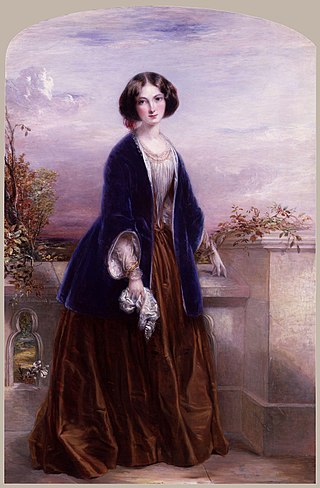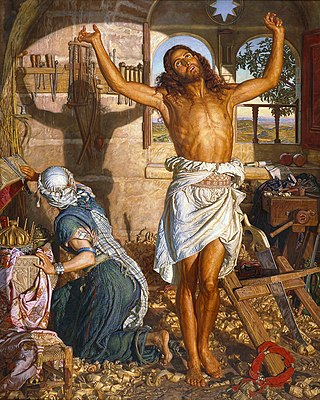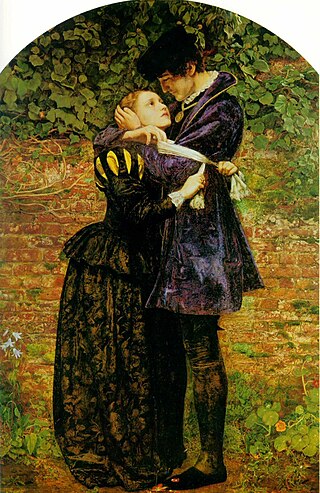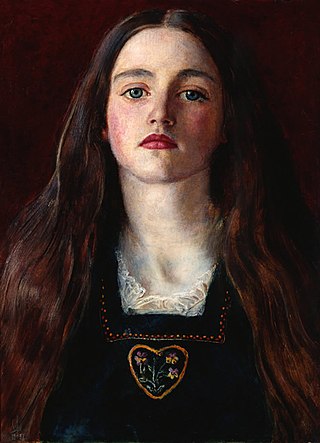Related Research Articles

Euphemia Chalmers Millais, Lady Millais was a Scottish artists' model and writer who was married to Pre-Raphaelite painter John Everett Millais. She had previously married the art critic John Ruskin, but she left him with the marriage never having been consummated; it was subsequently annulled. This famous Victorian "love triangle" has been dramatised in plays, films, and an opera.

Sir John Everett Millais, 1st Baronet was an English painter and illustrator who was one of the founders of the Pre-Raphaelite Brotherhood. He was a child prodigy who, aged eleven, became the youngest student to enter the Royal Academy Schools. The Pre-Raphaelite Brotherhood was founded at his family home in London, at 83 Gower Street. Millais became the most famous exponent of the style, his painting Christ in the House of His Parents (1849–50) generating considerable controversy, and he produced a picture that could serve as the embodiment of the historical and naturalist focus of the group, Ophelia, in 1851–52.
Events from the year 1849 in art.

The Shadow of Death is a religious painting by the English painter William Holman Hunt, on which he worked from 1870 to 1873, during his second trip to the Holy Land. It depicts Jesus as a young man prior to his ministry, working as a carpenter. He is shown stretching his arms after sawing wood. The shadow of his outstretched arms falls on a wooden spar on which carpentry tools hang, creating a "shadow of death" prefiguring the crucifixion. The arch of the window also creates a natural halo around the head of Christ. His mother Mary is depicted from behind, gazing up at the shadow, having been looking into a box in which she has kept the gifts given by the Magi.

A Huguenot, on St. Bartholomew's Day, Refusing to Shield Himself from Danger by Wearing the Roman Catholic Badge (1851–52) is the full, exhibited title of a painting by John Everett Millais, and was produced at the height of his Pre-Raphaelite period. It was accompanied, at the Royal Academy of Arts in London in 1852, with a long quote reading: "When the clock of the Palais de Justice shall sound upon the great bell, at daybreak, then each good Catholic must bind a strip of white linen round his arm, and place a fair white cross in his cap.—The order of the Duke of Guise." This long title is usually abbreviated to A Huguenot or A Huguenot, on St Bartholomew's Day.

Mariana is an 1851 oil-on-panel painting by John Everett Millais. The image depicts the solitary Mariana from William Shakespeare's Measure for Measure, as retold in Tennyson's 1830 poem "Mariana". The painting is regarded as an example of Millais's "precision, attention to detail, and stellar ability as a colorist". It has been held by Tate Britain since 1999.
Francis Morse, M.A. was a priest in the Church of England.
The Gipsies Football Club was a short lived 19th century rugby football club that was notable for being one of the twenty-one founding members of the Rugby Football Union, as well as producing a number of international players in the sport's early international fixtures.
The Marlborough Nomads was a 19th-century English rugby union club that was notable for being one of the twenty-one founding members of the Rugby Football Union. They also supplied a number of players for the sport's early international fixtures.
Ravenscourt Park was a short lived 19th century English rugby union club that was notable for being one of the twenty-one founding members of the Rugby Football Union, as well as supplying a number of international players for the sport's early international fixtures.
Law, or The Law Club as it was also known, was a 19th-century football club that fielded teams playing by rugby football codes. It is notable for being one of the twenty-one founding members of the Rugby Football Union and for producing in a very short life span, a number of international players.

Alfred St George Hamersley was a nineteenth-century solicitor and entrepreneur of great renown, an English MP, and an English rugby union international who played in the first ever international match. He went on to captain his country's team, and later was instrumental in establishing the sport in the south of New Zealand and in British Columbia.
There was a single international friendly between the England and Scotland national rugby union teams in the 1871–72 season. With no other recognised rugby union teams in Great Britain or the rest of the world, the encounter between Scotland and England represented the only possible match that could be arranged, and would continue as such until 1875, when Ireland formed their national team.
The 1872–73 Home Nations rugby union matches was a single international friendly held between the England and Scotland national rugby union teams. With no other recognised rugby union teams in Britain or the rest of the World, the encounter between Scotland and England represented the only possible match that could be arranged, and would continue as such until 1875, when Ireland formed a national team.
The 1873–74 Home Nations rugby union matches was a single international friendly held between the England and Scotland national rugby union teams. With no other recognised rugby union teams in Britain or the rest of the World, the encounter between Scotland and England represented the only possible match that could be arranged, and would continue as such until 1875, when Ireland formed a national team.
The 1874–75 Home Nations rugby union matches are a series of international friendlies held between the England, Ireland and Scotland national rugby union teams. This season of games was notable as it saw the first international appearance of the Ireland team.

Francis Luscombe was a rugby union international who represented England from 1872 to 1876. He also captained his country.

Sophia Margaret "Sophie" Gray, later Sophia Margaret Caird, was a Scottish model for her brother-in-law, the Pre-Raphaelite painter John Everett Millais. She was a younger sister of Euphemia "Effie" Gray, who married Millais in 1855 after the annulment of her marriage to John Ruskin. The spelling of her name was, after around 1861, sometimes "Sophy," but only within the family. In public she was known as Sophie and later in life, after her marriage, as Sophia.
John Alexander Dew was an English cricketer. Dew was a right-handed batsman who fielded as a wicket-keeper. He was born at Horsham, Sussex.
References
- 1 2 3 4 5 Sydney Morse Profile on scrum.com
- ↑ The Times, Monday Sept 20 1886, page 9
- ↑ Marlborough College, Marlborough College register from 1843 to 1904 inclusive: With alphabetical index, p210, Edition 5, (H. Hart, printer, 1905)
- ↑ Francis Marshall, Football, The Rugby Union Game, p148 (1892)
- ↑ The Very First Match – thevarsitymatch.com
- ↑ Francis Marshall, Football, The Rugby Union Game, p269 (1892)
- 1 2 3 4 National Portrait Gallery re provenance of portrait of Sir John Everett Millais
- 1 2 The Times, 28 January 1929 page 1